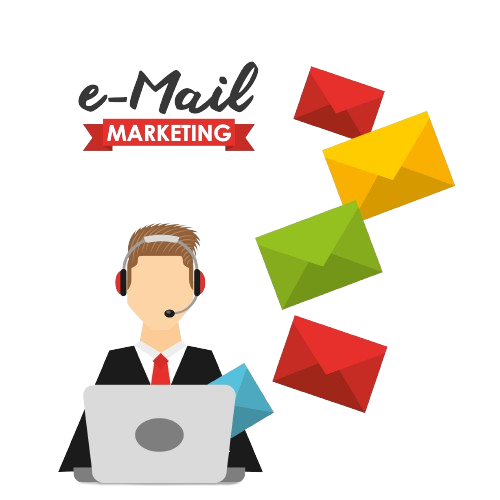
In the ever-evolving landscape of digital marketing, where trends come and go like fleeting seasons, one strategy has proven its resilience and effectiveness time and again – Email Marketing Software. This age-old yet dynamic method continues to be a powerhouse for businesses seeking to connect with their audience on a personal level. However, success in email marketing is not just about drafting a compelling message; it’s about understanding and implementing the fundamental principles that drive engagement and conversions. So, let’s delve into the 5 T’s of Email Marketing – the pillars that stand tall in the realm of successful email campaigns, but before that let’s take a look into the history of email marketing’s evolution.
The Evolution of Email Marketing: The Timeless Power of Personal Connection
The evolution of email marketing traces a remarkable journey from its humble beginnings to becoming a sophisticated and integral component of digital marketing strategies. In the early days, email marketing was characterized by simple, text-based messages that were sent to large lists without much personalization. But with technological advancement, email marketing allowed marketers to experiment with HTML emails, and incorporate visuals and design elements to enhance engagement.
By the 2000s there was a surge in the use of email marketing automation, which allowed businesses to send more targeted and personalized email campaigns. Email marketing made it possible for businesses to segment audiences based on behavior and demographics, which then became standard practice and led to increased relevance for recipients. Moving forward, the advent of mobile devices further transformed email marketing, as responsive designs became a necessity to cater to users on various screens.
In recent years email marketing software started focusing more on hyper-personalization, AI-driven content recommendations, and interactive elements to boost user engagement. Moreover, email marketing is now abiding by stringent data privacy regulations, such as GDPR, to help marketers like you prioritize consent and transparency in their email practices. Moreover, today, email marketing has become the motto of creativity and data analytics, which is helping marketers leverage advanced tools to deliver tailored, timely, and value-driven content to their audiences.
Now that you have understood how email marketing and email marketing software have evolved to be one of the most used tools by today’s marketers, let’s unravel its 5 T’s to see why it is a must-have for businesses like yours.
The 5 Ts of Email Marketing
The 5 Ts of email marketing include:
1. Targeting: Hitting the Bullseye

Email marketing’s first and foundational “T” is Targeting, a strategic approach to segmenting your audience for personalized communication. In the ever-expanding digital landscape, where consumers are inundated with information, reaching the right audience with a tailored message is crucial for success. Here’s how the targeting feature of email marketing software can help you:
- Understanding Your Audience
Targeting begins with a deep understanding of your audience, this involves not only demographic information such as age, location, and gender but psychographic factors like interests, behaviors, and preferences as well. This feature of email marketing software can help you comprehend who your audience is and what they seek, which can eventually help you craft messages that resonate with your customers’ needs and foster a stronger connection.
- Segmentation: Dividing for Relevance
Segmentation is the cornerstone of effective targeting. With the segmentation feature of email marketing instead of employing a one-size-fits-all approach, you can divide your audience into segments based on shared characteristics. Email marketing software uses factors like purchase history, engagement level, or even preferences expressed through surveys to divide your customers, this can help you to motivate your customers to go further down the sales funnel.
- Personalization for Impact
Once you’ve identified segments, with the personalization feature of email marketing you can take the next step of motivating your customers to make the final purchase. The personalization feature of email marketing software goes beyond addressing recipients by their first names; it helps you tailor the content of your emails to match the specific interests and needs of each segment.
2. Timing: The Art of Perfect Sequencing

The second “T” in email marketing, Timing, is a critical element that can significantly impact the success of your campaigns. By helping you understand when to send your emails, email marketing software helps you not only reach your audience’s inbox but capture their attention at the most opportune moments as well. Here’s how the timing feature of email marketing software can help you:
- Strategic Scheduling for Audience Habits
The cornerstone of timing is aligning your email dispatch with the habits of your target audience. By helping you know when your subscribers are most likely to check their emails, email marketing enhances the probability of your message being seen promptly. For instance, if you’re targeting a B2B audience, by sending emails during typical business hours email marketing software can increase your open rates compared to evenings or weekends.
- Consideration of Time Zones
In this interconnected world, where audiences span different time zones, considering these variations is crucial. Sending emails at a time suitable for your local audience might mean that your international subscribers receive them at inconvenient hours. However email marketing software often provides features that can allow you to schedule your email campaigns based on the time zone of your recipients, meaning you can ensure a globally considerate approach.
- Frequency and Consistency
Beyond the specific timing of individual emails, the overall frequency and consistency of your campaigns contribute to timing effectiveness, and if you are bombarding your subscribers with daily messages it can lead to email fatigue and increased unsubscribe rates. However, email marketing software helps you strike the right balance and maintain a consistent schedule, with which you can manage expectations and eventually make your audience more receptive to your communications.
- Seasonal and Event Timing
Certain events, holidays, or seasons may present opportunities or challenges for your email campaigns, and email marketing software helps you cater to these special events specifically. Email marketing software can set reminders and help you be mindful of these external factors. This means you can ensure that your emails align with the broader context, and resonate with your audience.
- A/B Testing for Optimal Timing
Given the diversity of audiences and industries, there is no one-size-fits-all approach to email timing, and in this scenario, the A/B testing feature of email marketing software can become a valuable tool for you. The A/B testing feature of email marketing software can help you determine the optimal timing for your specific audience, experiment with different sending times, and analyze the performance metrics to understand when your emails are most effective. Besides, over time, with this feature of email marketing, you can also refine your strategy based on these insights.
3. Tailoring: Personalization Beyond the First Name

The third “T” of email marketing, Tailoring, transcends simple personalization as it is associated with creating customized and relevant experiences for your recipients. Here’s how the tailoring feature of email marketing software can help you:
- Beyond First Names: True Personalization
While addressing recipients by their first names is a starting point, true personalization delves much deeper, and with email marketing software you can achieve just that. The tailoring feature of email marketing software can allow you to use customer data to understand individual preferences, behaviors, and interactions. By leveraging this information, you can create content that speaks directly to the unique needs and interests of each recipient, and enhance the overall impact of your emails.
- Dynamic Content for Adaptive Messaging
A key aspect of the tailoring feature of email marketing software is its ability to allow you to use dynamic content that adapts based on the recipient’s behavior or characteristics. This adaptive messaging can not only enhance the relevance of your emails but also increase the likelihood of conversion by helping you showcase items that align with the interests of your customers.
- Behavioral Triggers for Timely Communication
Behavioral triggers are powerful tools in tailoring email campaigns and email marketing software can activate these triggers based on specific actions or inactions by your recipients. For instance, email marketing software might send a follow-up email with a discount code if a customer abandons their shopping cart. With this timely and tailored communication, you can significantly enhance conversion rates.
- Personalized Subject Lines for Increased Open Rates
The impact of tailoring extends to the subject lines of your emails and email marketing software helps you do just that. By providing automated templates, email marketing software allows you to personalize subject lines, reference the recipient’s name, recent purchase, or other relevant information, to significantly increase open rates. Besides, it also helps you create a sense of individualized communication, with which you can capture the attention of your customers amidst the sea of emails in their inbox.
- Emotional Connection through Tailoring
Tailoring is not just about data; it’s about creating an emotional connection with your audience. With email marketing software you can understand the pain points of your customers, their aspirations, and preferences, which can allow you to craft messages that resonate on a deeper level. Plus, by infusing emotion into your emails, you can build a stronger bond with your audience, to foster loyalty and trust.
4. Testing: Continuous Improvement Through Analysis

The fourth “T’ in email marketing, Testing, revolves around the continuous experimentation and refinement of various elements within your email campaigns. A/B testing, in particular, is a powerful tool that enables you to gather insights into what resonates most effectively with your audience, ultimately leading to more successful and impactful campaigns. Here’s how the testing feature of email marketing software can help you:
- A/B Testing Essentials
At its core, the A/B testing feature of email marketing software involves comparing two versions of an element in your email to determine which performs better. This could include testing different subject lines, email copy, images, calls-to-action, or even the overall layout. By using this feature of email marketing software, you can isolate one variable at a time, and pinpoint the specific elements that can contribute to higher engagement and conversion rates.
- Subject Line Experimentation
Subject lines play a pivotal role in email open rates, and the A/B testing feature of email marketing software can allow you to experiment with different subject line approaches. With the A/B testing feature of email marketing software, you can compare personalized vs. generic, short and intriguing vs. detailed and informative, or urgency-focused vs. curiosity-inducing emails, and by analyzing these results you can gain insights into the types of subject lines that can most effectively capture the attention of your audience.
- Content Variation for Improved Engagement
The A/B testing feature of email marketing software extends to the content within your emails. With this feature of email marketing software, you can experiment with different messaging styles, lengths, and tones to understand what resonates best with your audience.
- Design and Layout Considerations
The visual appeal and layout of your emails can significantly impact engagement. With the A/B testing feature of email marketing software, you can determine the most effective design elements, including the use of images, colors, and the placement of calls-to-action. Besides, iterative testing can empower you to gradually refine your email’s aesthetic based on audience response.
- Metrics Analysis for Informed Decision-Making
Last but not least, metrics analysis is integral to the testing process. This feature of email marketing software goes beyond just identifying the winning variation, it can help you understand the underlying metrics, such as open rates, click-through rates, and conversion rates, while providing you with valuable context. Plus, with this data-driven approach of email marketing software, you can make informed decisions about which elements contribute most significantly to the overall success of your email campaigns.
5. Tracking: Analytics for Informed Decision-Making

Ultimately, the fifth “T” in email marketing, Tracking, is a crucial component that involves the meticulous analysis of campaign performance metrics. So. let’s explore how the tracking feature of email marketing software can help you:
- Essential Metrics for Tracking
The tracking feature of email marketing software begins with the monitoring of key performance indicators (KPIs) that provide a comprehensive view of campaign success. These include open rates, click-through rates, conversion rates, and unsubscribe rates, and each metric offers unique insights into different aspects of your recipient’s journey, which can help you understand the strengths and weaknesses of your campaigns.
- Open Rates: Gauging Initial Engagement
Open rates reveal the percentage of recipients who opened an email, and a high open rate indicates compelling subject lines and a strong initial engagement. Email marketing software helps you analyze these open rates, which can help you assess the effectiveness of your subject lines and the overall appeal of your emails.
- Click-Through Rates: Assessing Content Engagement
Click-through rates measure the percentage of recipients who click on a link within your emails. This metric can provide you with insights into the relevance and attractiveness of your content. By analyzing click-through rates, email marketing software can help you identify the most engaging elements of your emails and refine future content accordingly.
- Unsubscribe Rates: Addressing Opt-Out Trends
Unsubscribe rates measure the percentage of recipients who choose to opt out of future communications. While some level of unsubscribes is normal, a sudden spike may indicate issues with the relevance or frequency of your content. However, email marketing software allows you to monitor unsubscribe rates, this can help you to identify and address potential concerns to retain your subscriber base.
- Advanced Analytics: Moving Beyond Basic Metrics
Beyond basic metrics, advanced analytics features of email marketing software offer a deeper understanding of campaign performance. Customer lifetime value (CLV), return on investment (ROI), and attribution modeling can provide you insights into the long-term impact of your email campaigns on your revenue and customer engagement. Besides, these advanced metrics can also aid in assessing the overall success and contribution of email marketing to your business’s objectives.
- Data-Driven Decision-Making
The true power of tracking lies in its ability to inform data-driven decision-making. By allowing you to continuously monitor and analyze campaign performance, email marketing software can help you to adapt your strategies in real time and optimize your success. For example, if a particular subject line consistently performs well, you can apply similar approaches to future campaigns.
Conclusion
In the realm of digital marketing, where trends come and go, email marketing has proven its resilience as a powerful and versatile tool. The 5 T’s—Targeting, Timing, Tailoring, Testing, and Tracking, provide a comprehensive framework for navigating the intricacies of email marketing. By embracing precision in audience segmentation, strategic scheduling, personalized experiences, continuous experimentation, and data-driven decision-making, you can seamlessly elevate your email campaigns to new heights.
As technology continues to advance and consumer behaviors evolve, staying attuned to the 5 T’s can ensure that your email marketing strategy remains not only relevant but highly effective at the same time. So, embrace the art of email marketing by choosing the right email marketing software for your business, and unlock the full potential of this timeless channel to engage, convert, and build lasting relationships with your audience.